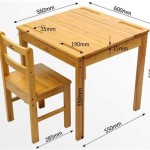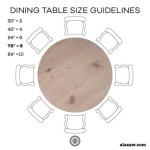Standard Dining Table Width: A Comprehensive Guide
The dining table serves as a central point in many homes, facilitating shared meals, conversations, and memories. Selecting the right dining table involves considering several factors, including size, shape, material, and style. Among these, the width of the dining table plays a crucial role in determining both the comfort of diners and the overall functionality of the dining space. Understanding the standard dining table width and its implications is essential for making an informed purchase.
This article aims to provide a comprehensive overview of the standard dining table width, discussing its importance, variations, factors influencing the ideal width, and its relationship with different table shapes. By exploring these aspects, individuals can make well-informed decisions when choosing a dining table that optimally suits their needs and spatial constraints.
The Significance of Dining Table Width
The width of a dining table directly impacts the dining experience in several ways. Primarily, it defines the amount of space available for placing food and drinks. An inadequate table width can lead to overcrowding and a cramped dining experience, making it difficult for diners to comfortably access shared dishes or place their individual plates and glasses.
Furthermore, the table width influences the ease of conversation. When the table is too narrow, diners may feel too close together, making it challenging to maintain a comfortable personal space. Conversely, an excessively wide table can create a sense of distance, hindering easy communication and hindering a cohesive dining atmosphere. Finding the optimal balance is crucial for comfortable and convivial dining.
Moreover, the aesthetic appeal of a dining room is intrinsically linked to the proportions of the table. A dining table that is either too narrow or too wide relative to the room's dimensions can disrupt the visual harmony of the space. A well-proportioned table enhances the overall aesthetic appeal and contributes to a balanced and inviting dining environment.
Standard Width Dimensions for Different Table Shapes
While there isn't a single universally defined "standard" width for all dining tables, certain dimensions are commonly accepted and used as guidelines, particularly for different table shapes. The ideal width generally varies to accommodate the inherent characteristics of each shape and the number of people it is designed to seat.
Rectangular Dining Tables: These are among the most popular choices. The standard width for a rectangular dining table typically falls within the range of 36 to 48 inches. A width of 36 inches is generally considered the minimum for comfortably accommodating dishes in the center of the table while still allowing ample space for diners on either side. A width of 42 to 48 inches provides even more space, reducing the risk of overcrowding and offering greater flexibility in terms of centerpiece arrangements and serving platter placement.
Square Dining Tables: Square tables are best suited for seating four people. Standard widths usually range from 36 to 48 inches. A 36-inch square table may feel somewhat compact, especially if large serving dishes are placed in the center. A 48-inch square table offers more generous space, making for a more comfortable and less constrained dining experience.
Round Dining Tables: Round tables foster a sense of intimacy and encourage conversation. The diameter of a round table dictates its seating capacity. A table with a diameter of 48 inches usually seats four people comfortably. To seat six, a diameter of approximately 60 inches is recommended. For eight people, a 72-inch diameter table is usually required. It's crucial to remember that round tables often require more floor space than rectangular tables due to their circular footprint.
Oval Dining Tables: Oval dining tables offer a compromise between the rectangular and round shapes. They provide ample surface area like rectangular tables while maintaining a softer, less angular appearance. Standard widths for oval tables are similar to those of rectangular tables, generally ranging from 36 to 48 inches. The length, however, is a crucial factor influencing seating capacity.
Factors Influencing the Ideal Dining Table Width
Several factors should be considered when determining the ideal dining table width. These factors relate to the available space, the number of people typically seated at the table, and the intended usage of the table beyond just dining.
Dining Room Size: The dimensions of the dining room are paramount. A table that is too large will overwhelm the space, making it difficult to move around comfortably. Conversely, a table that is too small will appear insignificant and out of proportion. It is advisable to measure the dining area carefully and ensure that there is sufficient space around the table to allow for comfortable seating and movement. A general guideline is to leave at least 36 inches of space between the edge of the table and any walls or furniture.
Seating Capacity: The number of people who will regularly use the dining table is a primary determinant of the appropriate width. A larger width may be necessary to accommodate more diners comfortably and to provide sufficient space for serving dishes. Consider both everyday seating needs and the occasional need to accommodate guests. For instance, if one typically dines with four people but occasionally hosts dinner parties for eight or more, a table with extendable leaves or a larger width might be a suitable solution.
Intended Use: The primary purpose of the dining table influences the ideal width. If the table is exclusively used for dining, a standard width may suffice. However, if the table is used for other activities such as homework, board games, or crafting, a greater width may be preferable to provide ample surface area. Furthermore, if the table is used as a buffet surface during gatherings, a wider table becomes essential to accommodate serving dishes and beverages.
Personal Preferences & Style: Personal preference plays a significant role in selecting the ideal dining table width. Some individuals prefer a more intimate dining experience with diners seated closer together, while others prefer a greater sense of space. Furthermore, the overall style of the dining room can influence the choice of table width. A modern, minimalist dining room may benefit from a sleek, narrower table, while a more traditional dining room may accommodate a wider, more substantial table.
In conclusion, determining the standard dining table width requires careful consideration of several factors, including the table shape, dining room size, seating capacity, intended use, and personal preferences. Consulting with interior design professionals or furniture specialists can provide further guidance in making an informed decision. The goal is to select a table that seamlessly integrates into the dining space, provides a comfortable dining experience, and complements the overall aesthetic of the home.

A Guide To Choosing The Ideal Dining Table Width

A Guide To Choosing The Ideal Dining Table Width

Dining Table Dimensions Measurements

20 Dining Room Design Ideas Round Table Sizes Dimensions

Useful Standard Dimensions For Home Furniture Engineering Discoveries Dining Table Sizes Design

What Is The Ideal Dining Table And Chair Height

Pin By Heather Thomas On House Dining Table Sizes 12 Person Dimensions

Standard Dining Table Dimensions And Sizes Designcafe

Standard Dining Table Dimensions The Size Guide

The Dining Room Table Size Guide Ideal Sizes For 4 6 And 8 Seater Tables








